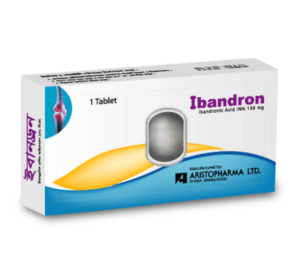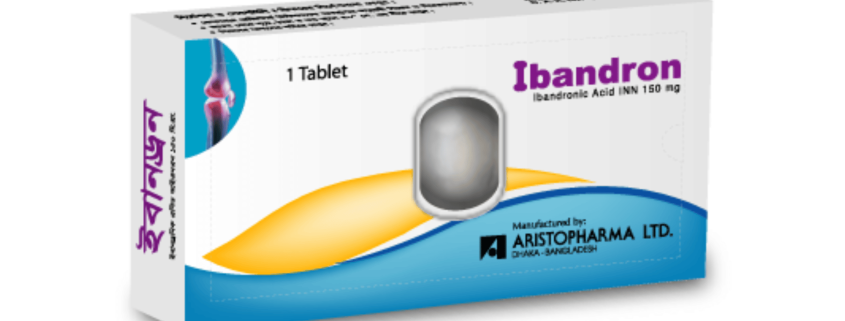Ibandron (Ibandronic Acid)

Therapeutic Group : NSAID & Analgesic
Presentation:
Ibandron Tablet: Each film coated tablet contains Ibandronate Sodium INN equivalent to Ibandronic Acid 150 mg.
Indications:
Ibandron is indicated for the treatment and prevention of osteoporosis in postmenopausal women. Ibandron increases bone mineral density (BMD) and reduces the incidence of vertebral fractures.
Dosage & Administration:
The dose of Ibandron is one 150 mg tablet once monthly on the same date of each month.
Ibandron tablet should be taken at least 1 hour before the first food or drink (other than water) of the day and before taking any oral medications containing multivalent cations (including antacids, supplements or vitamins).
To facilitate delivery to the stomach, and thus reduce the potential for esophageal irritation, Ibandron tablets should be swallowed whole with a full glass of plain water (6 to 8 oz) while the patient is standing or sitting in an upright position. Patients should not lie down for 1 hour after taking Ibandron. Plain water is the only drink that should be taken with Ibandron. Patients should not chew or suck the tablet because of a potential for oropharyngeal ulceration.
The Ibandron 150 mg tablet should be taken on the same date of each month (i.e. the patient’s Ibandron day).If the once-monthly dose is missed, and the patient’s next scheduled Ibandron day is more than 7 days away, the patient should be instructed to take one Ibandron 150 mg tablet in the morning following the date that it is remembered. The patient should then return to taking one Ibandron 150 mg tablet every month in the morning of their chosen day, according to their original schedule.
The patient must not take two 150 mg tablets within the same week. If the patient’s next scheduled Ibandron day is only 1 to 7 days away, the patient must wait until their next scheduled Ibandron day to take their tablet. The patient should then return to taking one Ibandron 150 mg tablet every month in the morning of their chosen day, according to their original schedule. Patients should receive supplemental calcium and vitamin D if dietary intake is inadequate. Intake of supplemental calcium and vitamin D should be delayed for at least 1 hour following oral administration of Ibandron in order to maximize absorption of Ibandron. Physicians should be alert to signs or symptoms signaling a possible esophageal reaction during therapy, and patients should be instructed to discontinue Ibandron and seek medical attention if they develop symptoms of esophageal irritation such as new or worsening dysphagia, pain on swallowing, retrosternal pain, or heartburn.
Contrainidications:
Ibandronic Acid is contraindicated in any patient who has shown a hypersensitivity reaction to the drug or to any of the excipients, hypocalcemia and inability to stand or sit upright for at least 1 hour.
Warning & Precautions:
Hypocalcemia and other disturbances of bone and mineral metabolism should be effectively treated before starting therapy with Ibandronic Acid. Adequate intake of calcium and vitamin D is important in all patients.
Side effects:
The most common side effects include back pain, allergic reaction, dyspepsia, diarrhea, nausea, vomiting, gastritis, myalgia, headache, dizziness, vertigo etc.
Drug interaction:
Products containing calcium and other multivalent cations (such as aluminum, magnesium, iron), including milk, food, and antacids are likely to interfere with absorption of Ibandronic Acid. It should be taken at least 1 hour before any oral medications, including medications containing multivalent cations (such as antacids, supplements or vitamins). Also, patients should wait at least 1 hour after dosing before taking any other oral medications. Caution should also be exercised in the concomitant use of aspirin or NSAIDs with Ibandronic Acid.
Use in special groups:
Use in pregnancy: Pregnancy Category C. There are no adequate and well-controlled studies in pregnant women. It should be used during pregnancy only if the potential benefit justifies the potential risk to the mother and fetus.
Use in nursing mothers: It is not known whether it is excreted in human milk. Because many drugs are excreted in human milk, caution should be exercised when it is administered to a nursing woman.
Pediatric use: Safety and effectiveness in pediatric patients have not been established.
Geriatric use: No overall differences in effectiveness or safety were observed between elderly patients and younger patients. Therefore, no dosage adjustment is necessary in the elderly.
Hepatic insufficiency: No studies have been performed to assess the pharmacokinetics of Ibandronic Acid in patients with hepatic impairment because Ibandronic Acid is not metabolized in the human liver.
Renal insufficiency: It is not recommended for use in patients with severe renal impairment (creatinine clearance of < 30 mL/min).
Packing:
Ibandron Tablet: Each box contains 1’s tablet in alu-alu blister pack.



